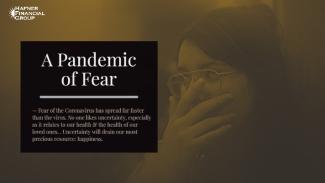
A Pandemic of Fear
As February began, most investors were keeping a cautious eye on the coronavirus that was spreading in China. While there were isolated outbreaks around the globe, they were just that—isolated.
Some firms began to back away from prior financial forecasts, but a mistaken belief the illness would be contained to China kept markets at inflated levels.
That changed dramatically when headlines surfaced that the coronavirus had spread to northern Italy, South Korea and Iran.
The good news: new cases appear to have considerably slowed in China as of March 1, according to Worldometer, which combines data from global health organizations.
The illness is spreading in Italy and South Korea. Iran isn’t far behind, but it’s widely believed the economically isolated nation is dramatically underreporting the intensity of the virus.
What’s behind the market sell-off? Driven by computer sell programs that take their cues from headlines, the hit to stocks originates amid anxieties that coronavirus will damage the U.S. and global economy.
When it was contained to China, there were fears that shuttered factories would disrupt the flow of parts that are made in China and are used by U.S. companies. Economists call this a ‘supply shock.’ As the name implies, a supply shock reduces the supply of goods available to businesses and consumers.
Today, there are growing worries that any disruptions to normal routines could also pressure the demand for goods and services, delaying a projected acceleration in corporate profits this year. Economists refer to this as a ‘demand shock.’
Earnings in 2019 are forecast to rise just under 1% from 2018 (Refinitiv). For 2020, profits are forecast to rise 7.7% (Refinitiv, Feb 28). However, as analysts begin to ratchet down forecasts in response to the change in economic sentiment, these recent projections are probably out of reach.

Perspective: Coronavirus and past epidemics
So far, the damage has been contained to the stock market, as the virus has shifted the calculus and created heightened uncertainty. Put another way, heightened uncertainty simply means that the number of economic outcomes has widened. In this case, they are all to the downside.
But, are investors overreacting? Is the public overreacting? The flu has infected 32 million-45 million people in the U.S. this season per the CDC, which began on October 1. There have been 310,000-560,000 hospitalizations, and tragically, 18,000-46,000 deaths. Yet, our daily routine goes on uninterrupted.
In comparison, just 88 Americans have contracted the coronavirus as of March 1. Per the Wall Street Journal, “The new virus is particularly challenging for public-health officials because people who are infected and transmitting to others might have only mild flu-like symptoms, or no symptoms at all, making them difficult to identify.”
Knowing the virus creates only “mild flu-like symptoms” in some people may alleviate some worries. (Of course, the elderly and those with compromised health must be more cautious.)
On the other hand, compared to the seasonal flu, the coronavirus seems to be more contagious and deadlier, despite the fact that confirmed U.S. cases number a fraction of the annual flu.
Health officials do not have a complete understanding of the virus, but our knowledge is progressing.
While we don’t know if this will eventually turn into a significant health crisis, we’ve lived with epidemics before, including the measles, polio, SARS, MERS, H1N1, and the flu, which strikes every year and can be deadly.
During the H1N1 pandemic of 2009 (coronavirus has yet to be deemed a pandemic by the World Health Organization), there were approximately 60.8 million cases, 274,304 hospitalizations, and 12,469 deaths in the U.S. between April 12, 2009 to April 10, 2010. Despite the human toll, stocks were already in the early phase of a bull market.
Today, we’re being pelted by wall-to-wall media coverage of the coronavirus. In 2009, the media may have been more focused on a new president and the Great Recession, limiting the hysteria.

Fear spreads fast, but keep perspective
While we can critique the media and stock market reactions, what we know is that the market has sold off. Fear has spread far faster than the virus. As we enter March, the economy is on a solid footing, and the banking system is in much better shape than 2008.
On February 28, Federal Chief Jerome Powell reaffirmed, “The fundamentals of the U.S. economy remain strong,” but added he is “closely monitoring developments and their implications for the economic outlook. We will use our tools and act as appropriate to support the economy.”
The last sentence is the Fed’s way of hinting that a rate cut or other actions are being carefully considered.
That said, we know that volatility in markets is inevitable, but has typically been short-lived. Stocks seem to take the stairs up and the elevator down. This bout of volatility will end, but calling a bottom is virtually impossible. You and I know that no one has a window on the future.
Once again, I will emphasize that your holistic financial plan incorporates your goals and is crafted based on a number of factors, including your risk preferences and time horizon.
It is a roadmap to your financial goals. It incorporates the inevitable market declines and keeps one from making rash decisions when markets turn volatile. Or, for that matter, when stocks surge ahead and one may be tempted to take a more aggressive but riskier posture.
I recognized that these are trying times, not simply from the vantage point of the investment community. No one likes uncertainty, especially as it relates to our health and the health of our loved ones.
Uncertainty drains our most precious resource: happiness. Turn off the news, get outside, and turn to what brings you peace. I am confident that this too shall pass, and we will be better for it.
If you have any thoughts, questions, or concerns, feel free to reach out to me. That’s what I’m here for. My door is always open.
| Key Index Returns | ||
| Index | MTD% | YTD % |
| Dow Jones Industrial Average | -10.1 | -11.0 |
| Nasdaq Composite | -6.4 | -4.5 |
| S&P 500 Index | -8.4 | -8.6 |
| Russell 2000 Index | -8.5 | -11.5 |
| MSCI World ex-USA* | -9.1 | -10.9 |
| MSCI Emerging Markets* | -5.4 | -9.8 |
| Bloomberg Barclays US Aggregate Bond TR | 1.8 | 3.8 |
Source: Wall Street Journal, MSCI.com, Morningstar, MarketWatch
MTD returns: Jan 31, 2020–Feb 28, 2020
YTD returns: Dec 31, 2019–Feb 28, 2020
*USD

